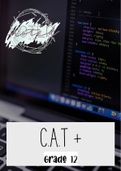c.a.t +
, System technologies & implications
Computers in our everyday lives
WHY DO WE USE COMPUTERS? [PROCESSORS]
EFFICIENCY, ACCURACY, AND RELIABILITY
EFFICIENCY: Time
& Computers work faster than humans can.
& A wide range of time consuming tasks can be performed on a
bigger scale
Work
& Computers have reduced the labour involved in mentally
intensive and repetitive physical tasks
& They can also perform tasks that can be dangerous for
people to perform on their own.
Resources
& Resources cost money and computers can be programmed to
work more efficiently with resources.
& Technology can also be used to monitor and limit carbon
emissions in factories and cars, to keep the air we breathe
cleaner.
ACCURACY: & As long as computers have quality programs and quality data, it is
extremely accurate. Repeatable accuracy is essential in mass
production on assembly lines
& If the software is correct, the computer can perform the same
tasks over and over with 100% accuracy.
What aspects ensure that computers are accurate?
application programs + data = high quality
RELIABILITY: & Computers can be relied on to do tasks accurately, without
getting tired, getting bored, complaining, or asking for more
money.
& Computers help us to record and use data efficiently. Computers
do this by allowing users to work in an organized and competent
way. This way a user can get a lot of work done with little
effort
& Efficient data entry is aided by accurate data entry. Accurate
data entry is aided by the use of data validation techniques such
as input masks and validation rules.
& Computers process data reliably. As long as users enter the data
accurately, the computers can be relied upon to provide accurate
output. Computers do not have to take leave for vacations or
2
, even for sleep. The 'garbage in, garbage out' (GIGO) principle
refers to the fact that inaccurate inputs will result in inaccurate
outputs.
COMMUNICATION: The efficiency, accuracy and reliability of computers, combined with
the ability to communicate, enables us to:
& virtually eliminate time and distance as business restrictions
& communicate and share information in many different ways
worldwide (ICT gives us a wide range of communication methods.
You can share files and even work on the same document with
others at the same time. Information can be shared via websites
and even generated together)
& save on communication costs (We can use VoIP software like
Skype to make calls at a fraction of the cost of a traditional
phone call. It is also no longer necessary to spend large sums of
money on postage. The same documents can be sent is shared to
or electronically with people around the world at a fraction of
the cost (or even for free) via the internet.)
& have social interaction on a global scale. Social networking tools
(like Facebook, Twitter, Instagram, Snap Chat and Pinterest) and
blogs (online journals) are used to share and socialize with others
around the world
OLD DAYS: suppliers take longer communication = slower pace of
business transactions
NOW: Global Range + Speed (Computers) = Reduce Time and Distance
TYPES OF COMPUTER SYSTEMS
When you want to compare computers, you need to look at factors such as the
following:
1.How powerful they are - this usually refers to the specifications of the computers,
such as the speed of their CPUs, and how much RAM they have installed.
2. What they are used for - for example, some computers function as servers in a
network, while others are used mainly for basic office applications and the Internet.
3. Their size (mobility) - computers can range from large (mainframe) computers that fill
large rooms to laptops, tablets and smartphones.
4.The software they use - we often refer to the type of operating systems as
'platforms' and refer to computers as 'Linux machines' or 'Windows machines'
(5.PRICE)
3
, TYPES OF COMPUTER SYSTEMS
NON- These computers usually consist of a system unit, screen, mouse and
PORTABLE keyboard.
COMPUTERS
Non-portable computers are large in size, are not intended to be moved
around, and are generally more powerful than mobile or portable
computers.
The all-in-one units are easier to transport and take up less space, but
are more difficult to repair or upgrade.
We can distinguish the following types of computers that are non-
portable:
& A work / DESKTOP computer is what most people buy when they buy a
non-portable computer. Computers with lower specifications cost
less.
& A server is a powerful computer used to provide resources and
services to all the computers connected in a network
Benefits of non-portable computers
1. more powerful than portable
2. "all-in-one" version = easy transport + takes up less space
PORTABLE A portable computer uses a traditional operating system (Windows, Linux
COMPUTERS and macOS) and hardware designed for portability - that is, the
hardware has an all-in-one design. It includes the screen, keyboard, and a
pointing device that is usually housed in an enclosure designed to fold to
take up less space, to be easy to carry, and to protect the delicate
parts of the computer. It also includes a battery so that it can be used
for a limited number of hours without access to an external power
source.
What type of desktops cost less?
Desktops with lower specifications i.e. :
1) lower processing speed
2) lower RAM
3) lower storage capacity
4




